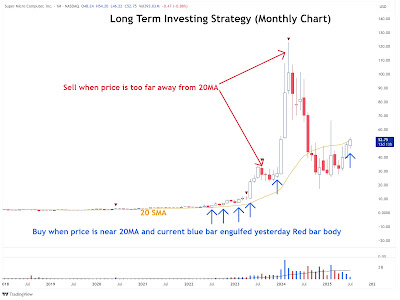Simple Trading System for free
DISCLAIMERS - The charts presented in this blog site is strictly for educational purposes and to keep track of my own analysis over the times. - They do not constitute investment advice in any manner whatsoever or have any regard to the specific investment objectives, financial situation or individual needs of any particular persons receiving them. -Please consult your personal financial planner for investment advice.
Thursday, December 11, 2025
Saturday, September 6, 2025
When to take partial profits?
to take some profits along the way.
For me, when there is a spike up of price and making new high, I would take
some profits or when price, 20MA and 200MA are far apart, this may also
alert me to take some profits and wait for the price to retrace to the support
level and evaluate if I should add more lots again. Continue to milk
the uptrend till the stock shows sign of weakness and high probability that it will
start to decline into start sideway consolidation (Stage3) or even stage 4
declining downward trend.
Happy Profitable Trading 2025!
Tuesday, July 29, 2025
Friday, July 18, 2025
Monday, June 16, 2025
Saturday, June 7, 2025
How to know if new uptrend is forming with high probability of more upsides to come?
up slowly.
the 20SMA and moves higher with volume.
the time to take a trade on the Long side.
withdraw consistently from the ATM.
Sunday, March 30, 2025
High Probability Trade Setup with Smart Indicators to Consistently Triggered Low Risk Buy and Milk the Trend as its goes Higher Up.
Trade Setup:
1) Enter a trade with Position Sizer to limit the Risk Dollar to take initially.
e.g. 1% of $50K capital, Risk dollar $500 for this trade.
2) Let the market does its job by moving price away from break even level and
subsequently moves higher and wait for retracement back to 20MA to ADD
MORE LOTS on the way up.
3) Every time when there is a sharp spike where price moves up to a level with
huge price bar and looking to the left side of the chart, there is no known
resistance, Smart Indicator showing 80 level, Sell some lots (e.g 50%)
and leaving the rest to test if the price continues to head higher up to reap
more gains and sell about another 30% of inventory.
4) Wait for the next retracement again along the uptrend, to add more lots to the
remaining 20% residue lots from point 3. Keep on milking the uptrend until
the stock reaches 75% or higher (refer to the 2nd diagram, 20MA starts to
flatten and turning down south towards 200MA).
5) Liquidate all the holdings. Be happy that you have fully Milked this stock and
Repeat scan for next stock and repeat the process from point 1 to 5 again.
Focus on precise trade execution, not counting Money during the trade.
Money will find you when you are well prepared and earned the Rights to
recieve the rewards
Lastly, don't give up your job. Continue to create multiple streams of
income is the ultimate goal.
This is how I plan my Swing Trades.
For Position Sizing and Profit and Loss Calculator,
refer to: Position Sizer Calculator
Happy Profitable Trading 2025!














